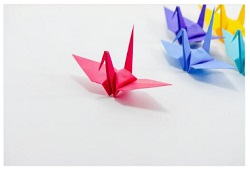Origami is the traditional Japanese art of folding paper into various shapes such as birds, animals and flowers.
They are made with square, colored pieces of paper without the use of scissors or paste.

Followings are further explanations which help you understand origami more.
Fold 1000 of them and make a wish
Here is a definition of origami.
Origami is a unique Japanese art in which various forms such as animals and flowers are dreated by folding square paper without the use of glue or scissors.
Most children learn how to make origami, and most people can make folded cranes. People customarily make 1000 folded cranes and link them together by thread in order to give them to a sick person, making a wish that the sikness will be cured soon.
Some think that Japanese are relatively skillful with their fingers because they are taught it as children.
Today origami is also taught in many coutries and is used to help teach geometry.
(An Introductory Handbook to Japan and Its People p.119)
History of origami: Started when paper became commonly used
Folding paper as an entertainment probably started about 1000 years ago.
origami
Folded paper; also the art of folding paper to form shaped figures and ornamental objects.
Origami ranges from a simple form of child’s play to complex art form. It is used in certain Japanese ceremonies and rituals, as well as for practical, educational, and entertainment purposes.
Background
Origami as a form of entertainment was not practiced during ancient times when paper was scarce and hence very valuable; it probably began during the Heian period(794-1185). Origami with only folding and no cutting developed first in the Muromachi period(1333-1568). In the Edo period(1600-1868)other techniques of folding, cutting, and dyeing paper were developed. By the Taisho period(1912-1926)patterns for some 150 different kinds of origami figures had been established. Contemporary origami is distinguished from paper cutting, paper sculpture, and kumigami(paper assembling). The new art of creative origami does not, generally speaking, use cutting or coloring techniques, and the main pattern of expression is cubic.
(Japan An Illustrated Encyclopedia pp.1158-1159)
Used for purification, wrapping, and teaching device
Uses for Origami
The oldest known use of origami in Japan is found in the KATASHIRO, used from ancient times in Shinto ceremonies at the Ise Shrine. The katashiro is a symbolic representation of a deity cut from special paper called jinguu yoshi(shrine paper). Vestiges of katashiro can still be found in the paper cutouts of human figures currently used in various purification ceremonies and in the paper dolls displayed on the occasion of the DOLL FESTIVAL in March. The GOHEI, or shide, an implement used in Shinto purificatory rituals, is made of paper that has been specially cut and folded.
katashiro(left)and kirinusa
gohei
Origami also plays an important part in formal etiquette. There are many different ways to fold wrapping paper for gifts presented on ceremonial occasions or on special days in the cycle of annual events. Weddings and funerals, in particular, require elaborate folded paper ornaments such as the male and female butterflies that adorn sake bottles. Paper folding has been an important part of Japanese folk ritual as well; for example, it is used in making NOSHI, a kind of traditional ornament attached to gifts, and tato, a kind of paper billfold or case carried in the breast fold of the kimono.
During the late Meiji period(1868-1912)and the Taisho period, origami was used as a teaching device in kindergartens and primary schools. In the beginning of the Showa period(1926-89), creativity came to be emphasized in Japanese education, and origami was criticized because children were required to handle the paper in standardized ways.Recently, however, origami has come to be appreciated one again as an educational technique. In particular, it is used to teach such concepts as the relationship between a plane and a solid.
(Japan An Illustrated Encyclopedia pp.1158-1159)
Origami in the World
Now origami is worldwide.
There are a few examples of early paper folding to be found in other parts of the world. Some folded paper considered Asian in origin was brought to Europe by the Moors in the 8th century. There is evidence that the Japanese origami for inu(dog)was imitated in Spain, England, and France in the form of a bird, horse, or hen.
The number of devotees of orgami and origami associations in Japan and abroad has rapidly increased in recent years.Origami associations are maintained in 14 foreign countries, including the United States, England, Italy, the Netherlands, and Peru.
(Japan An Illustrated Encyclopedia pp.1158-1159)





